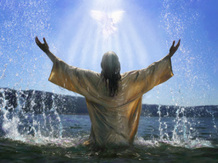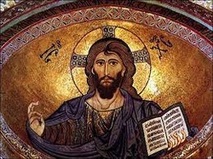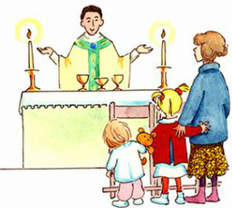Primary 1
Notes of Guidance:
At the beginning of term - read twice...
These notes provide an overview for the teacher for the purpose and direction of the learning across the P1 year.
Notes of Guidance:
At the beginning of term - read twice...
These notes provide an overview for the teacher for the purpose and direction of the learning across the P1 year.
Primary 1
Scripture texts:
Especially in Primary 1 pupils, engagement with scripture will be mediated by the teacher. Make sure you are familiar with the text - read or paraphrase - use an artefact to engage interest and curiosity. Revisit all texts several times in the year; allow choosing, play, art and drama responses from pupils.
In the Catholic tradition, proclamation and active listening to scripture is familiar to us. Link liturgical gestures to listening - this will support the invitation of faith practice.
Scripture texts:
Especially in Primary 1 pupils, engagement with scripture will be mediated by the teacher. Make sure you are familiar with the text - read or paraphrase - use an artefact to engage interest and curiosity. Revisit all texts several times in the year; allow choosing, play, art and drama responses from pupils.
In the Catholic tradition, proclamation and active listening to scripture is familiar to us. Link liturgical gestures to listening - this will support the invitation of faith practice.
Primary 1 : TIOF
Key Vocabulary and Images
As well as time to look closely. sometimes guided by the teacher to develop 'thinking routines'
As with all language learning, pupils learn by hearing,having visual cues, then speaking and eventually writing.
In TIOF we want to share the rich language of the Church's tradition in the context of faith professed, celebrated, lived and prayed.
The Key Vocabulary and visuals can be used in ppt/pdf form on your IWB or printed 2 to a page and laminated as sorting and chatter cards for a myriad of 'active learning' activities. Let the pupils take responsibility for selecting the images and 'pair and share' to deepen learning episodes.
10 things to do with Key Vocabulary Visuals:
1. Think, See, Wonder about visuals on IWB
2. Laminate visuals and Think, See, Wonder in Pair'n'share
3. Ask pupils to select images from cards related to lesson of the day.
4. Display images on a washing line above the altar/sacred space.
5. Ask pupils to sort cards:
sacrament, scripture, love of God, Love of neighbour - then explain their choices.
6. Ask pupils to choose one image as a stimulus for an art response - with a line of have a go writing - scripture or response
of praise, thanks.
7. Ask children in groups of 6 to choose a visual and tell their peers in Circle time what questions
they have or what they like about this.
8. Let pupils choose and muse on these cards - self-directed learning.
9. Use cards to prepare for a 'field trip' to a Church.
10. After the 'field trip' discuss similarities and differences of artefacts etc.
Key Vocabulary and Images
As well as time to look closely. sometimes guided by the teacher to develop 'thinking routines'
As with all language learning, pupils learn by hearing,having visual cues, then speaking and eventually writing.
In TIOF we want to share the rich language of the Church's tradition in the context of faith professed, celebrated, lived and prayed.
The Key Vocabulary and visuals can be used in ppt/pdf form on your IWB or printed 2 to a page and laminated as sorting and chatter cards for a myriad of 'active learning' activities. Let the pupils take responsibility for selecting the images and 'pair and share' to deepen learning episodes.
10 things to do with Key Vocabulary Visuals:
1. Think, See, Wonder about visuals on IWB
2. Laminate visuals and Think, See, Wonder in Pair'n'share
3. Ask pupils to select images from cards related to lesson of the day.
4. Display images on a washing line above the altar/sacred space.
5. Ask pupils to sort cards:
sacrament, scripture, love of God, Love of neighbour - then explain their choices.
6. Ask pupils to choose one image as a stimulus for an art response - with a line of have a go writing - scripture or response
of praise, thanks.
7. Ask children in groups of 6 to choose a visual and tell their peers in Circle time what questions
they have or what they like about this.
8. Let pupils choose and muse on these cards - self-directed learning.
9. Use cards to prepare for a 'field trip' to a Church.
10. After the 'field trip' discuss similarities and differences of artefacts etc.
P1 RERC 0-01a
Mystery of God
Mystery of God
P1 RERC 0-02a
Image of God
Image of God
P1 RERC 0-03a
P1 RERC 0-04a
Revealed Truth of God
P1 RERC 0-04a
Revealed Truth of God
P1 RERC 0-05a
P1 RERC 0-07a
Son of God
P1 RERC 0-07a
Son of God
P1 RERC 0-08a
Signs of God
Signs of God
P1 RERC 0-11a
Word of God
Narratives from the Old Testament:
The Creation: God makes all things out of love
The Flood: God recreates the world and makes a Promise.
Birth of Moses and the crossing of the Red Sea - Passover
Narratives from the New Testament:
An event: The Widow's mite
A parable: The Good Samaritan
Miracles: The healing of the man at the pool; the healing of the 10 lepers;
the wedding feast of Cana; Jesus walks on water and is Lord of Creation.
P1 RERC 0-12a
Word of God
Word of God
Narratives from the Old Testament:
The Creation: God makes all things out of love
The Flood: God recreates the world and makes a Promise.
Birth of Moses and the crossing of the Red Sea - Passover
Narratives from the New Testament:
An event: The Widow's mite
A parable: The Good Samaritan
Miracles: The healing of the man at the pool; the healing of the 10 lepers;
the wedding feast of Cana; Jesus walks on water and is Lord of Creation.
P1 RERC 0-12a
Word of God
P1 RERC 0-14a
P1 RERC 0-15a
P1 RERC 0-16a
P1 RERC 0-17a
P1 RERC 0-18a
Hours of God
P1 RERC 0-15a
P1 RERC 0-16a
P1 RERC 0-17a
P1 RERC 0-18a
Hours of God
P1 RERC 0-20a
P1 RERC 0-21a
Reign of God
P1 RERC 0-21a
Reign of God


























